What Does Sustainable Fashion Mean to Portland in 2025?
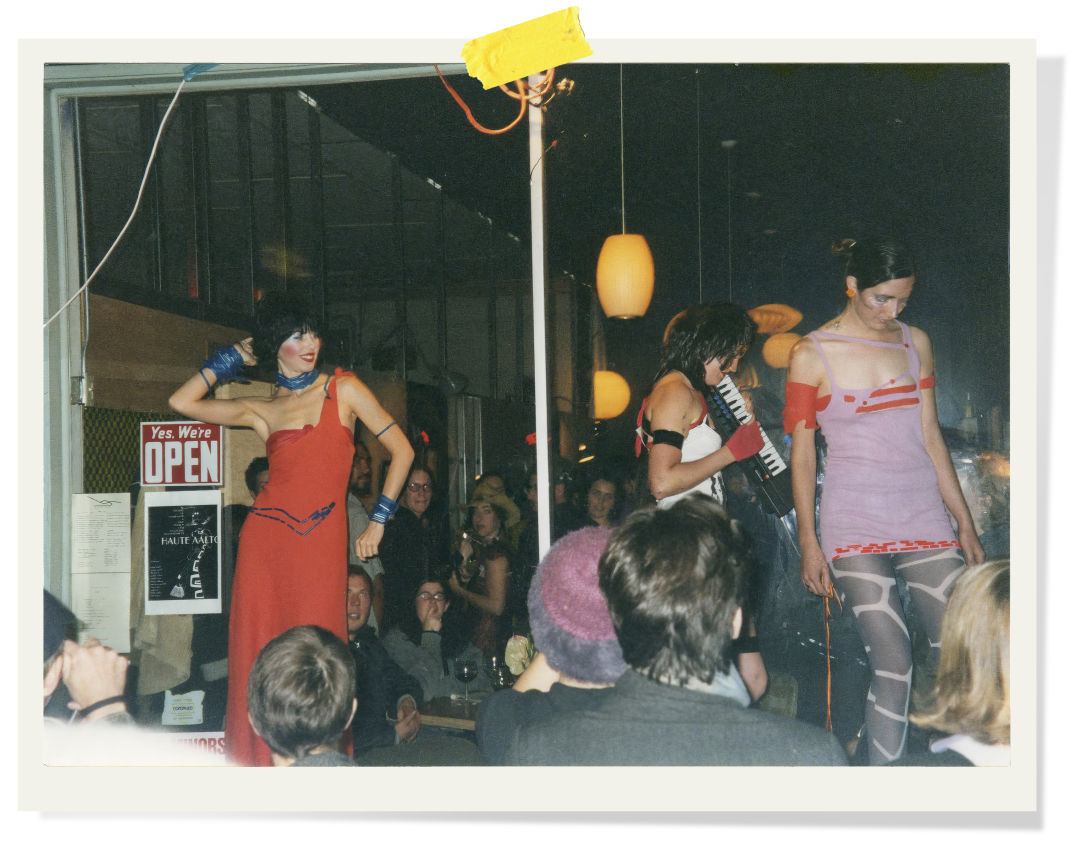
Glass Candy singer Ida No (left) walked in a sidewalk runway show at the influential boutique Seaplane in 2001.
In a photo from the first-ever Seaplane fashion show, in 2001, Glass Candy singer Ida No stands on a makeshift stage on the sidewalk outside the influential Portland boutique, cocking her arm behind her head like a diva. She has Liza Minnelli hair, red lips, and a redder dress that looks, with gritty elegance, like it’s made from torn and tied T-shirts. Chunky appliqué beads that could be borrowed from a jump rope cross her waist and wind in lengths around her neck and wrists. Though you can’t see it in the photo, the butt of her dress is cut out. “Yes, we’re open,” reads a sign on the window of the adjoined bar, Aalto Lounge.
“A zeitgeist was opened,” designer Adam Arnold reflected two decades later, his voice coming through a screen at Portland Fashion in the Aughts, an archival exhibition Portland State University hosted last fall. The runway shows fell off around the financial crash, but Portland’s dumpster-diving DIY fashion scene burned hot while it lasted. By 2007, Arnold was evangelizing its merits, telling one reporter that “Any designer who isn’t taking full advantage”—of the cheap rent, cheap materials, and game local audience—“is completely stupid.”
Patagonia would soon become a symbol of environmental consciousness, Toms (remember Toms?) of a charitable worldliness. But sustainability was not yet a marketing tool in 2001. “Going green” was still a punkish sport. The reworked, tattered clothes strutting down Portland’s curbside and warehouse catwalks carried little weight as tools for climate change advocacy. Designers were instead after a certain look and cheap fabric. Still, this eco-friendly side effect helped spark an ongoing discussion.

From left: Jordyn Bateman models a Jonny Shultz design (2007); models Sarah Garcia and Dustin Dis dressed by Adam Arnold (2003); Adam Arnold at a fitting in 2003.
Marjorie Skinner, who curated the PSU show, has seen the influence play out since she covered the upcycled salad days for the Portland Mercury. Regardless of early designers’ motivations, she says, “having a relationship with your clothing is inherently going to put the brakes on the disposability of it.”
It’s no coincidence that fast fashion hit its stride in the recession’s wake. It offered financially approachable versions of designer garments in a bankrupt moment and wrought a world of “good enough” dupes, ever faster and ever cheaper ad infinitum. No one believes Shein and Forever 21 clothes are comparable to the designs they crib. Instead, this market of knockoffs fundamentally changed our relationship to clothes, prizing deals and options over lasting quality. Though it has yet to burst like the subprime mortgage bubble, this storm of schlocky clothes is losing its allure as the consequences of gross overmanufacturing surface: microplastics, air pollution, water pollution, mountains of wasted fabrics, mountains of discarded clothes that saw one night of use.

Nicole Warren models a design by Emily Katz (2009); AdaZoe in a dress from Jaymes Neon’s label Birds of Prey (2010); Betsy Adams and Krystal South model designs by Claire La Faye.
The industry built an amorphous cloud of ideas called “sustainable fashion” in response, then stretched it to the point of meaninglessness: garments made with renewable resources, made locally to reduce their carbon impact, made anew from discarded clothing. All angles have their potential merits and pitfalls. But gathering the entire concept—of making clothes in ways that are vaguely better for the earth than others—under one umbrella is particularly fraught. In fact, sustainability’s explosion as a colossally profitable marketing phrase and the gimmicks that came with it have likely made the industry more destructive than it was 25 years ago.
More recently, the attention has shifted to how we use and care for garments. Sustainability looks like an ecosystem today, rather than a sales pitch. Designers are creating garments to fit into peoples’ lives with purpose. And boutiques and thrift shops play the critical role of translating designers’ ideas for shoppers, providing context for them to truly value their clothes.
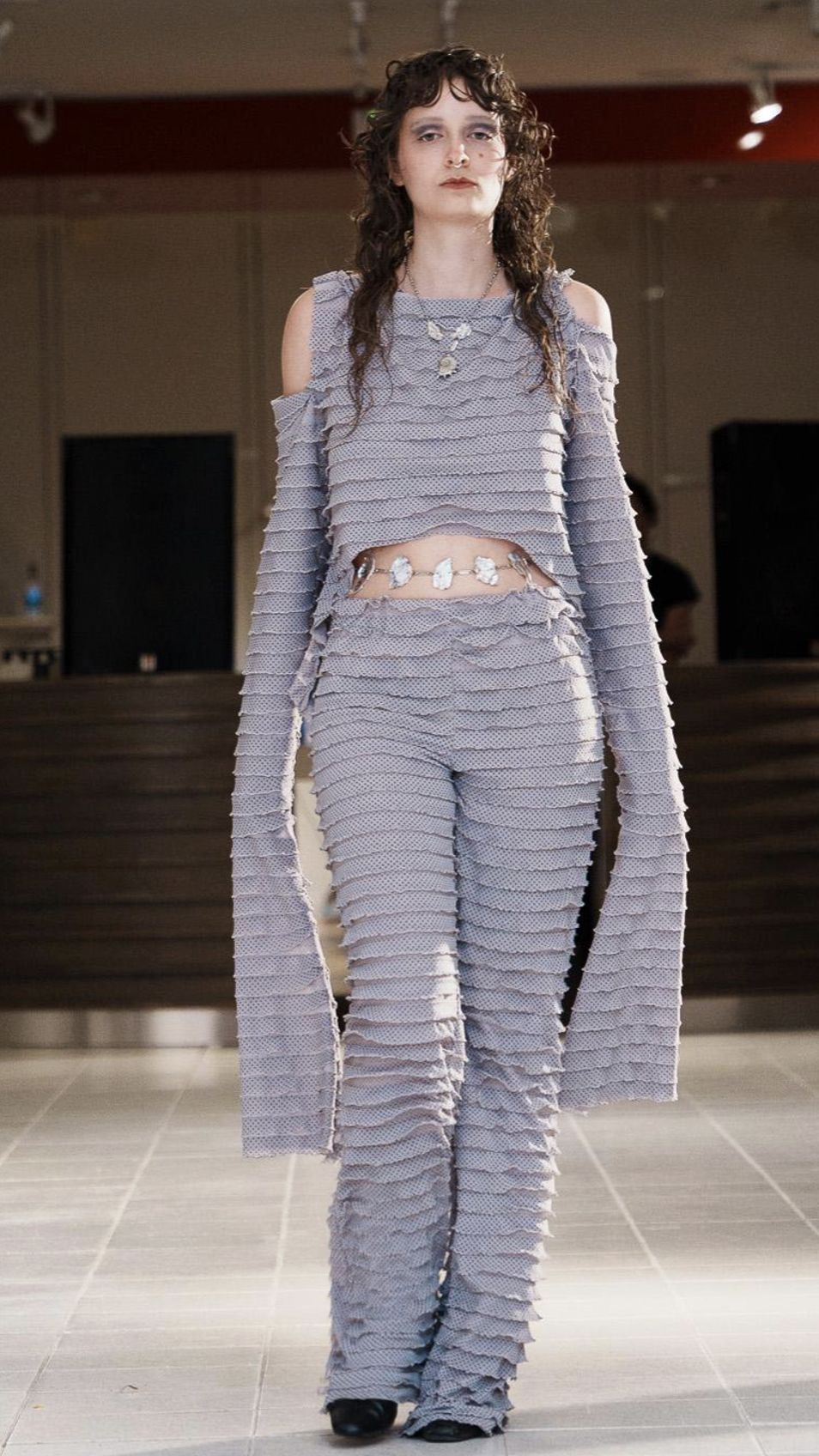
Model Ajani wearing a set designed by PSU sustainable fashion student Kelly Madden.
For Alison Heryer, the PSU professor behind the university’s new sustainable fashion program, sustainability is about agency. Her curriculum gives insight into every step of making and recycling clothing, in contrast to the industry’s traditionally siloed facets of raw materials, textiles, design, production, and retail. It’s in these gaps, Heryer says, that greenwashing flourishes: clothes made from plastic bottles, but only after those bottles are melted down in countries without pollution regulations; cotton produced in the US, only to be spun and dyed at a cheaper rate across the world before returning to stateside factories. One 360-degree example at PSU looks like sourcing discarded sweaters in partnership with Goodwill, stripping them down to wool fibers, respinning those into yarn, then knitting that yarn into new sweaters, or weaving it into a fabric for sewing new garments.
“Fashion in general is such an intersectional practice,” Heryer says. In the program’s short life, she’s seen clothing serve as a “tie-in” linking social practice, engineering, and queer and gender studies departments, giving each field context to consider how garments function in their areas of study and challenging fashion design students to consider more thoroughly what role the clothes they make will serve for their wearers. “Quite frankly,” Heryer says, “the students have very high standards for what they think is ethical and sustainable, and they will hold people to it.”
Versions of these ideas are already in practice at nearly every link in the proverbial food chain around Portland, whether labeled “sustainable” or not. Designer Nur Abbas calls the concept a “minefield” and doesn’t use it to describe his clothing line, gnuhr. “People argue for natural fibers, people argue for recycled fibers,” he says. But “I don’t know of a clear way through that has come out yet.”

Portland-based designer Nur Abbas’s label gnuhr straddles the worlds of fashion and high-performance backpacking gear.
Instead of sourcing and production dogmas, Abbas’s modest line of “ultralight” backpacking garments leverages high-performance technical fabrics with rigorously minimalist designs. He engineers patterns to reduce fabric scrap, which makes for intriguingly minimalist shirts, pants, and sweatshirts that carry traces of Abbas’s days designing for exalted European fashion houses like Gucci, Louis Vuitton, and Maison Margiela. The brand’s patent-pending “Tubular T,” for instance, is cut from a single tube of fabric and has only one seam across the back. But gnuhr’s most sustainable ideas are about making clothes people can truly care about. “Ultimately, I want to create something that has value and keeps its value,” Abbas says, “whether that is because it’s very useful and functional, or is desired as a cultural object.”
In tandem with designers, retailers and resale stores have an outsize influence on the lives and afterlives of our clothes. The worlds they create to sell them directly affect how we view them in our worlds. Locally, gnuhr sells through Stand Up Comedy, a boutique that supplants the consumerist approach to clothes shopping by treating garments more like art objects: meaningful and far from disposable. It’s also entirely possible that gnuhr garments will or perhaps already have shown up in some of the city’s more focused resale boutiques, another pillar of the ecosystem. Perhaps at Deep Lake, a consignment shop that envisions itself as the secondhand counterpart to considered boutiques like Stand Up Comedy.
Straddling lines of new and used, designers Holly Stalder and Kate Towers reprised some of the spirit they first bottled at Seaplane when opening their current boutique, Fine Art Fruit. Though they sold Seaplane in 2008, and it closed a few years later, the duo never stopped making clothes with a distinctly hands-on approach to sustainable fashion, using deadstock fabrics, upcycling textiles into things like folky bedsheet dresses, and by simply selling their made-in-Portland clothes in Portland. They don’t call it sustainable fashion either.
Share this content:
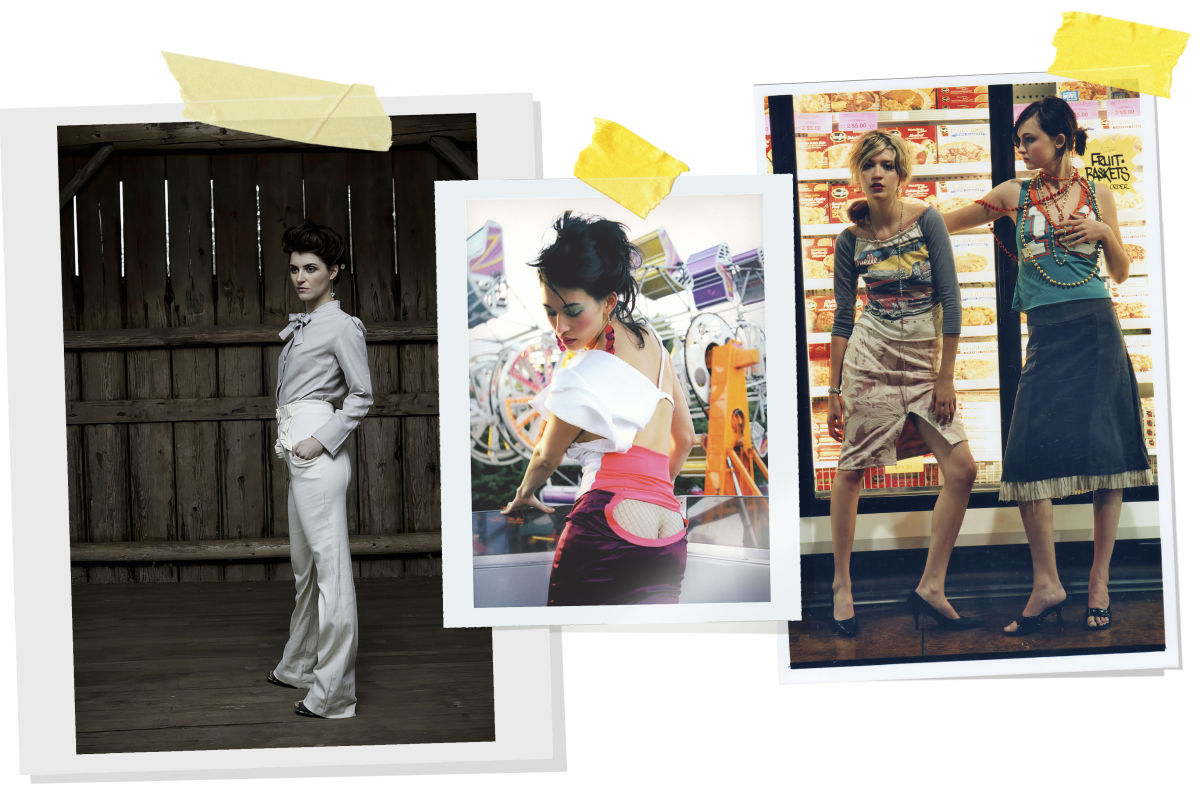

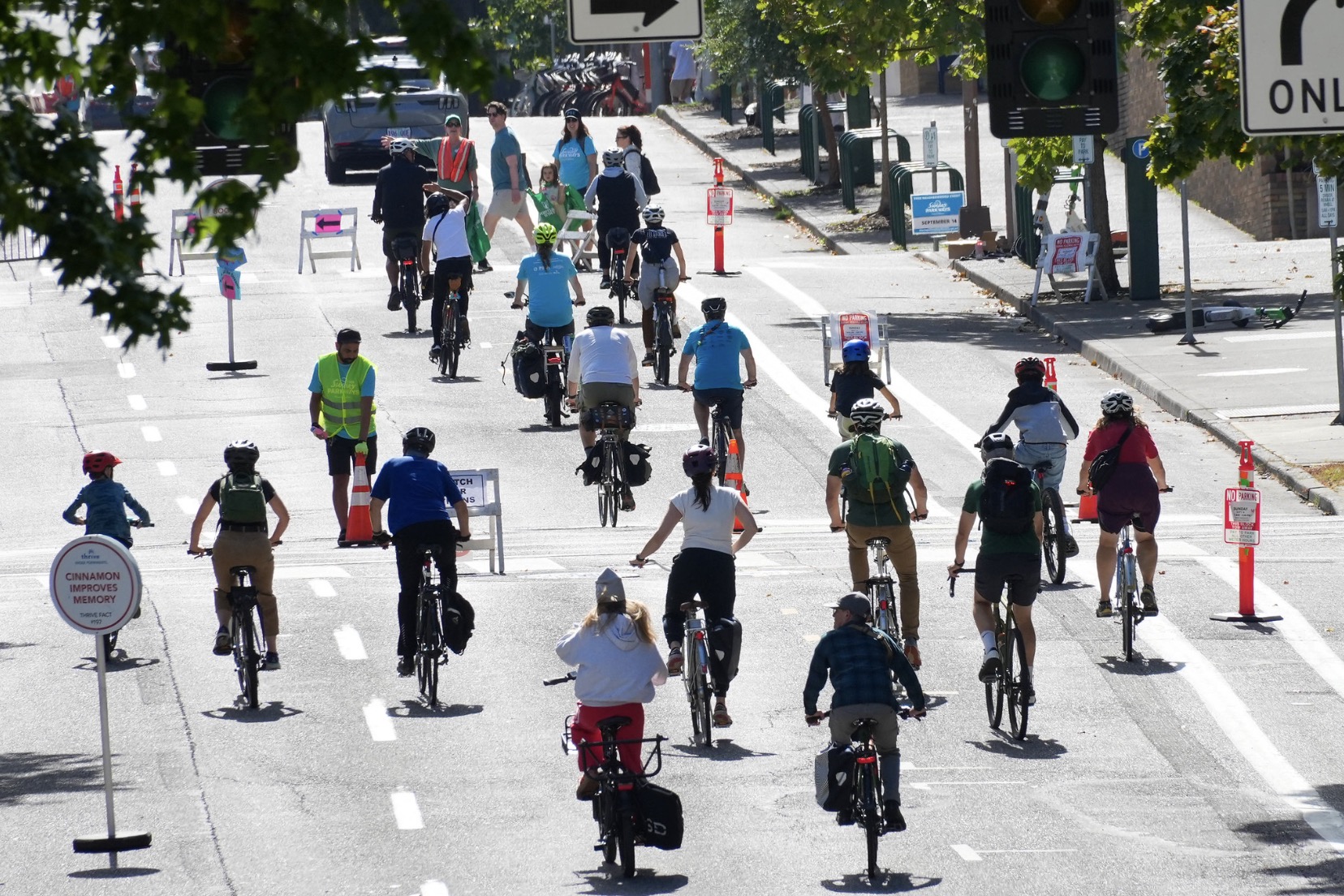

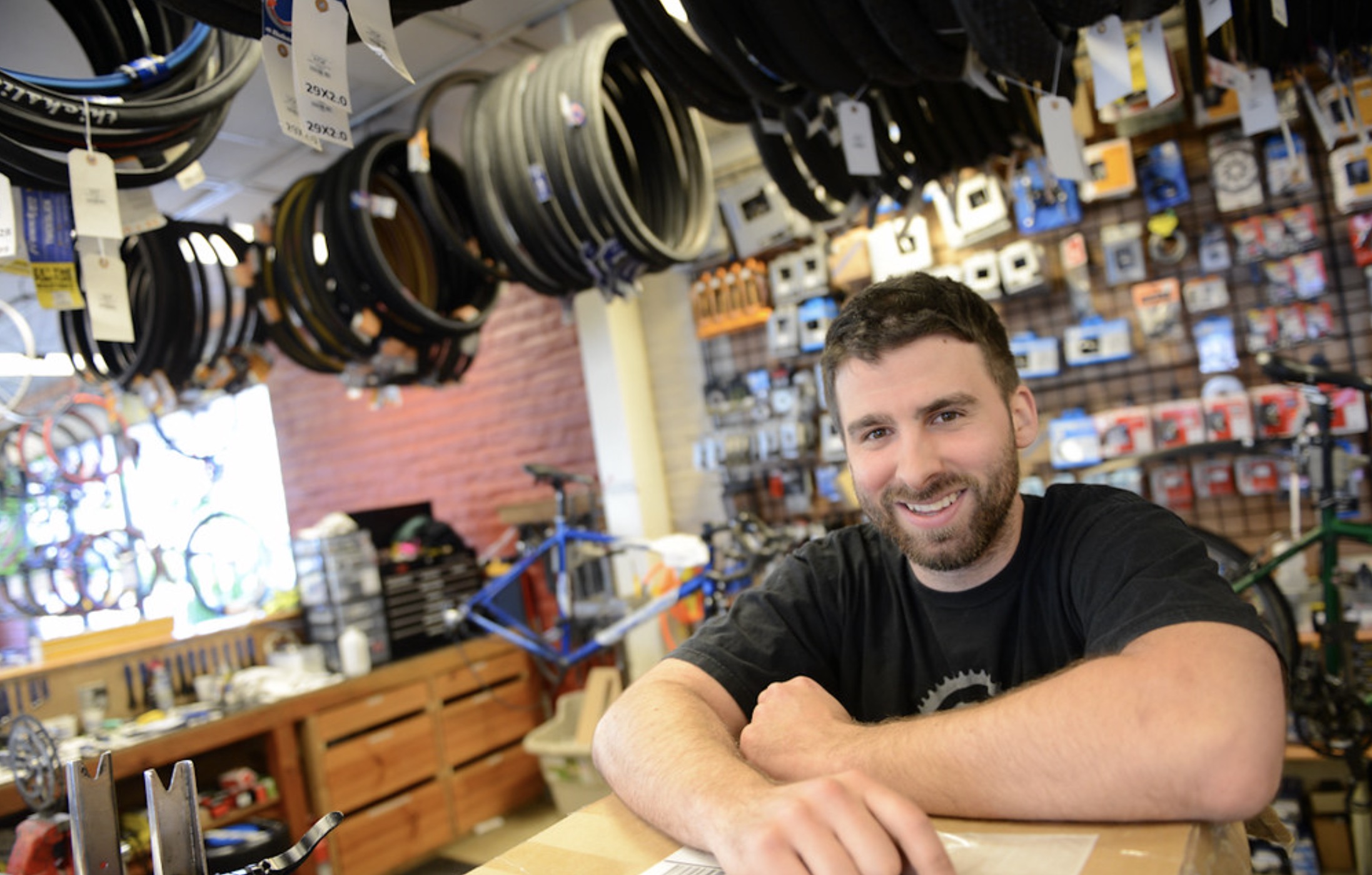


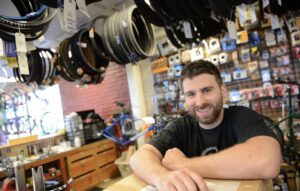





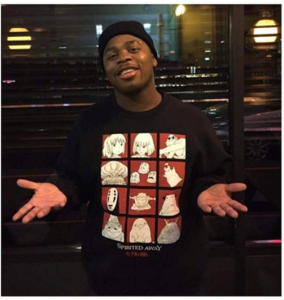

Post Comment